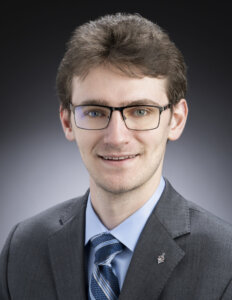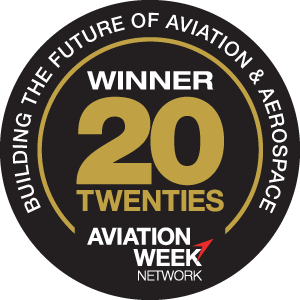 USC Viterbi School of Engineering student David Wolmark was just honored with Aviation Week Network’s 20 Twenties Class of 2022 award, in partnership with Accenture and sponsored by Hexcel. Wolmark, a full-time aerospace engineer in the Force Projection Sector of the Johns Hopkins University Applied Physics Laboratory (JHU/APL) in Laurel, Maryland, is pursuing his graduate degree through DEN@Viterbi program.
USC Viterbi School of Engineering student David Wolmark was just honored with Aviation Week Network’s 20 Twenties Class of 2022 award, in partnership with Accenture and sponsored by Hexcel. Wolmark, a full-time aerospace engineer in the Force Projection Sector of the Johns Hopkins University Applied Physics Laboratory (JHU/APL) in Laurel, Maryland, is pursuing his graduate degree through DEN@Viterbi program.
 The award, presented to twenty students each year selected from a competitive pool of nominees representing universities across the globe, honors students enrolled in bachelor’s or master’s degree programs in STEM fields who are “on course to change the face of the aerospace and defense industry.” In addition to highlighting academic performance in engineering, the award criteria emphasize community involvement and civic contributions, among other milestones.
The award, presented to twenty students each year selected from a competitive pool of nominees representing universities across the globe, honors students enrolled in bachelor’s or master’s degree programs in STEM fields who are “on course to change the face of the aerospace and defense industry.” In addition to highlighting academic performance in engineering, the award criteria emphasize community involvement and civic contributions, among other milestones.
Below is a brief Q&A with Wolmark.
What’s your earliest engineering/aviation memory?
As long as I can remember, I have always been passionate about understanding the world around me, taking things apart to learn what made them tick. Growing up on Long Island, NY, I was surrounded by the legacy of Grumman Aerospace Engineering, who manufactured such monumental vehicles as the Apollo Lunar Module and the F-14 Tomcat. I would spend days watching planes take off and land at La Guardia and Kennedy Airports, and I spent countless hours in the Cradle of Aviation Museum in Garden City, NY. When it came to choosing a career, aerospace engineering was the obvious choice. After obtaining a dual bachelor’s in aeronautical and mechanical engineering from Rensselaer Polytechnic Institute and entering the industry, I found that the DEN@Viterbi program at USC offered me the opportunity to expand my knowledge base in the areas which I am passionate about while simultaneously furthering my career – even three time zones away!
What thrills you about the aerospace industry?
For its entire history, the aerospace industry has always at the cutting edge of technological development. Right now there are new and exciting programs cropping up across the industry. While working at APL has given me the opportunity to get involved with many of these programs, furthering my education at USC has improved my ability to make valuable technical contributions.
What are your key projects/ notable projects from your time at Viterbi?
One notable project I completed as part of my coursework for AME532a was an investigation to demonstrate the efficacy of a moving mass control (MMC) system as a means of trimming and controlling the rotational dynamics of an aircraft. Historically, implementation of moving mass control systems have been isolated to reentry vehicle and spacecraft applications, however recent increasing interest in fixed wing UAV’s has reignited interest in MMC for fixed wing aircraft because of its advantages over aerodynamic control surfaces in high speed and high altitude flight regimes. In order to achieve the goals of the study, a six degree-of-freedom (6DOF) model of the ASW-28 glider model was developed with models for both traditional aerodynamic control surfaces and a simplified moving mass control system in Matlab/Simulink. This study was conducted as a semi-independent pursuit under the guidance of Dr. John McArthur. My interests in aerospace primary align with modeling and simulation of vehicle dynamics (both endo-atmospheric and exo-atmospheric), and this project was directly applicable to bolstering both understanding of the key principles in these fields as well as refining my capabilities of putting the theory into practice.
Outside of engineering, this award also emphasizes broader civic contributions. In what ways are you involved in your community?
Outside of engineering, I have been a certified Emergency Medical Technician (EMT) and have volunteered as a Firefighter/EMT in multiple fire departments and rescue squads across New York and Maryland since 2015. Currently, I serve as a Firefighter/EMT with the Laurel Volunteer Rescue Squad in Laurel, MD, serving at least one 12-hour shift per week staffing one of our fire engines or ambulances, responding to calls for aid in the Greater Laurel Area. I also have a passion for teaching and routinely work with new EMTs as a field training officer (FTO), helping them refine the basic skills they need to succeed and keep themselves safe. Some members of my departments have also been students at local colleges and I help tutor them in physics and mathematics in between emergency calls and fire/EMS training.
What is your vision/ goals for the future?
My education at USC through the APL Part Time Study Program has enabled me to grow in my position here at the lab and improve my technical contributions to the programs I am involved in. My vision for the future is to become a technical leader in my field and continue to do what APL does best – making “Critical Contributions to Critical Challenges.”
Published on August 16th, 2022Last updated on August 18th, 2022

